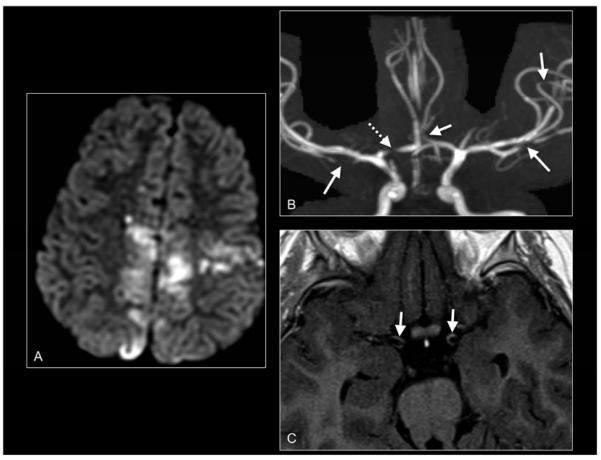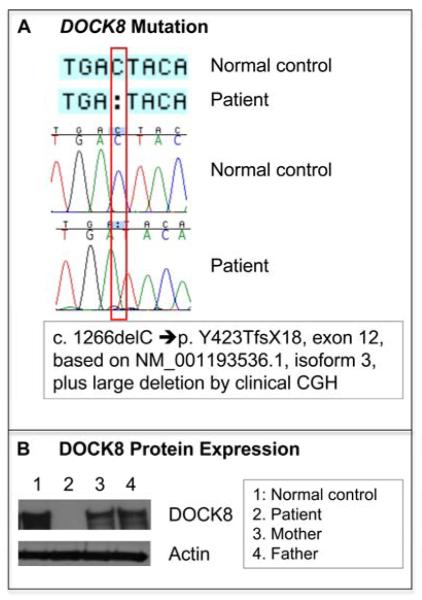To the Editor:
In contrast to autosomal dominant forms of hyper-IgE syndrome resulting from mutations in the STAT3 gene, autosomal recessive dedicator of cytokinesis 8 (DOCK8) deficiency, results in susceptibility to cutaneous viral infections, eosinophilia, and allergic disease. CNS manifestations have been reported in patients with DOCK8 deficiency, but progressive multifocal leukoencephalopathy caused by JC virus has been considered the only known viral etiology to date (1, 2).
A 6 year-old boy with atopy and recurrent peripheral blood eosinophilia developed acute intermittent vomiting, diarrhea, headache, and dizziness. Magnetic resonance imaging (MRI) of the brain was normal. One day later, he began giggling inappropriately, experienced left leg paresthesias, urinary incontinence, and fell upon attempting to stand. Repeat MRI with axial diffusion-weighted images revealed multiple areas of acute infarction in areas supplied by both anterior cerebral arteries, a branch of the anterior cerebral artery, the right posterior cerebral artery, and the left middle cerebral artery (Figure 1A). A complete blood count revealed a total eosinophil count of 2,160/μL, but no other abnormalities. He was treated with acetylsalicylic acid and intravenous methylprednisolone followed by oral prednisolone, 2 mg/kg for 3 days after which prednisolone was maintained at 1 mg/kg daily.
Figure 1. Manifestation of vaccine strain varicella zoster virus-induced central nervous system vasculopathy.
Axial diffusion weighted magnetic resonance image obtained after onset of neurological symptoms demonstrated scattered sites of acute ischemia involving the parasagittal cortices bilaterally and the left perirolandic cortex (panel A). Three-dimensional time of flight magnetic resonance angiographic image of the circle of Willis revealed multifocal stenotic anterior cerebral (short arrow), anterior communicating (dashed arrow), and middle cerebral (long arrows) arteries (panel B). Post-contrast T1W black blood arterial wall image illustrated avid enhancement and thickening of the distal supraclinoid internal carotid arterial walls bilaterally (panel C, arrows).
On presentation to us one month later, he had developed paresthesias of his hands. Neurological examination showed only mild weakness in the hands. Computed tomography angiogram revealed diffuse vasculopathy. Subsequent 3-dimensional time of flight magnetic resonance angiographic imaging of the circle of Willis revealed vascular narrowing and post-stenotic dilatation (Figure 1B). Post-contrast T1W black blood arterial wall imaging illustrated avid enhancement and thickening of the distal supraclinoid internal carotid arterial walls bilaterally (Figure 1C). Cerebral spinal fluid (CSF) was obtained. While awaiting results of testing for viral CNS infections, the patient was treated with acyclovir, 30 mg/kg intravenous daily, and maintained on oral prednisolone, 2 mg/kg/day.
The CSF at the time of diagnosis of vasculopathy contained 21 mononuclear cells and no red blood cells; protein was 39 mg/dL and glucose was 72 mg/dL. Quantitative PCR (Focus Diagnostics Reference Laboratory, Cypress, CA) amplified 7,116 copies of VZV DNA/mL in the CSF. To determine the VZV genotype, Förster Resonance Energy Transfer PCR was used to identify specific VZV DNA sequence polymorphisms within VZV open reading frames 38, 54, and 62, which distinguishes vaccine VZV from wild-type virus (Online Supplement Table 1) (3). This confirmed Oka varicella vaccine strain in the CSF. The CSF also contained anti-VZV IgG antibodies, but no antibodies to HSV-1 or HSV-2, enterovirus, cytomegalovirus, or Epstein-Barr virus were detected and the respective PCR analysis were similarly negative. The serum to CSF ratio of anti-VZV IgG antibody was markedly decreased (ratio 2.3) compared to albumin (ratio 149). Two weeks after treatment with acyclovir, the neurologic examination was completely normal, the CSF was acellular, and PCR was negative for VZV DNA.
The patient received routine immunizations including VZV vaccination at 12 months of age. He had 3 episodes of vesicular rashes at ages 3, 4, and 5 years, which always occurred after completing a course of oral corticosteroids. The first rash tested positive for HSV. The second rash was identical. The third rash at age 5 years with vesicles on the lower thigh was diagnosed clinically as zoster. All rashes resolved on oral acyclovir.
Past history included early-onset atopic dermatitis, food allergies often with anaphylaxis, biopsy-confirmed eosinophilic esophagitis, asthma and recurrent upper respiratory tract infections. Peripheral blood eosinophilia peaked at 9,000 eosinophils/μL and serum IgE at 472 IU/mL. During flares of respiratory or skin disease, he was treated with oral corticosteroids intermittently for 3 to 5 days, a few times annually. The frequency of such treatment increased and between ages 5½ and 6, he was treated with oral corticosteroids 1 to 2 times monthly during the prior 6 months.
Conventional comparative genomic hybridization array analysis revealed a large deletion of exons 1 to 13 in a single allele of the DOCK8 gene. PCR analysis of genomic DNA and DOCK8 gene sequencing identified a single base pair mutation on the opposite allele at exon 12, resulting in a frame shift and premature stop codon: c.1266delC, p.Y423TfsX18, based upon reference sequence NM_00193536.1, isoform 3 (Figure 2A). Western Blot analysis confirmed lack of DOCK8 protein expression (Figure 2B). Parental testing demonstrated that the large exon deletion was inherited from the mother while the point mutation was inherited from the father. Immunological findings are summarized in Supplemental Table 2.
Figure 2. DOCK8 molecular analyses.
A single base pair mutation at exon 12, resulting in a frame shift and premature stop codon: c.1266delC → p.Y423TfsX18, based upon reference sequence NM_00193536.1, isoform 3, was identified by DOCK8 gene sequencing, in addition to a large deletion on the opposite allele by clinical comparative genetic hybridization (panel A). T cells from the patient failed to express DOCK8 protein (panel B). Cell lysates were prepared from the patient (lane 2), parents (lanes 3, 4) and a healthy control (lane 1). Lanes were each loaded with 30 μg of protein. Immunoblotting for DOCK8 or actin proteins was performed as described.
The neurological symptoms and signs, imaging and CSF abnormalities, virological studies, and response to antiviral treatment were all features characteristically seen in VZV vasculopathy (4). Evidence of both focal and diffuse CNS disease was corroborated by widespread infarction produced by stenosis of multiple large cerebral arteries. The CSF examination revealed a pleocytosis as found in two-thirds of patients with VZV vasculopathy and both VZV DNA and anti-VZV IgG antibody with reduced serum/CSF ratios of anti-VZV IgG antibody were detected, indicative of intrathecal synthesis of anti-VZV IgG. Analysis of VZV DNA in CSF revealed that the VZV genotype was vaccine strain, demonstrating, for the first time, that VZV reactivation after vaccination in childhood can result in VZV vasculopathy.
Although the underlying immunological consequences of DOCK8 deficiency remain to be fully elucidated, multiple immune system abnormalities may account for enhanced susceptibility to viral infection including impaired dendritic cell migration affecting T cell priming, lymphopenia, defective CD8 T cell activation and expansion, decreased production of the anti-viral cytokines IFN-γ and TNF-α, impaired T cell survival, decreased NK cell cytotoxicity, and antibody abnormalities (5-9). Germinal center formation and survival of germinal center B cells are impaired in DOCK8 deficiency, leading to defective long-lived antibody production (8). Responses to protein or polysaccharide-conjugated vaccines are often variable while responses to previously encountered viruses such as HSV and VZV have been normal as demonstrated here for VZV antibodies in serum and CSF.
As in some other young patients with DOCK8 deficiency, this patient tended toward the milder spectrum of the disease with a relatively limited history of cutaneous infections, absence of severe systemic infections other than chronic mild otitis, and the modestly elevated serum IgE level. Instead, eosinophilia and moderate-severe eczema, asthma, and food sensitivities predominated. To control these conditions, courses of oral corticosteroids were administered with increased frequency over time. Interestingly, each of the 3 episodes of cutaneous viral infections with HSV or VZV was preceded by a course of oral corticosteroids. It is possible corticosteroids alone enabled the activation of vaccine strain VZV infection. More likely, the use of oral corticosteroids to gain disease control reduced the patient’s “immunologic threshold” and together resulted in reactivation of vaccine strain VZV and subsequent vasculopathy.
In summary, a young patient with significant atopic disease and widespread infarction produced by stenosis of multiple large cerebral arteries was shown to express novel mutations on both alleles of the DOCK8 gene. For the first time, VZV vasculopathy was shown to be due to the vaccine strain. This case highlights the importance of considering the possibility of DOCK8 deficiency in the context of severe allergic disease and the potential risks for CNS infection including VZV vaccine-related vasculopathy.
Supplementary Material
ACKNOWLEDGMENTS
We acknowledge the excellent care and support of the many staff at National Jewish Health and Children’s Hospital Colorado. The NIAID Institutional Review Board approved the study protocol and the parents provided written informed consent on behalf of the patient for participation. The findings and conclusions in this report are those of the authors and do not necessarily represent the views of the Centers for Disease Control and Prevention, US Department of Health and Human Services. The content is solely the responsibility of the authors and does not necessarily represent the official views of the NHLBI or the NIH.
Sources of Funding: This work was supported in part by the National Institutes of Health (NIH) (EWG) and the Intramural Research Program of the NIH, NIAID (HCS). Dr. Jordan Abbott was supported by a fellowship from CSL Behring and Dr. Angela Sabry was supported by a fellowship from Grifols.
Footnotes
Publisher's Disclaimer: This is a PDF file of an unedited manuscript that has been accepted for publication. As a service to our customers we are providing this early version of the manuscript. The manuscript will undergo copyediting, typesetting, and review of the resulting proof before it is published in its final citable form. Please note that during the production process errors may be discovered which could affect the content, and all legal disclaimers that apply to the journal pertain.
REFERENCES
- 1.Zhang Q, Davis JC, Lamborn IT, Freeman AF, Jing H, Favreau, et al. Combined immunodeficiency associated with DOCK8 mutations. N Engl J Med. 2009;361:2046–55. doi: 10.1056/NEJMoa0905506. [DOI] [PMC free article] [PubMed] [Google Scholar]
- 2.Freeman AF, Holland SM. Clinical manifestations of hyper IgE syndromes. Dis Markers. 2010;29:123–30. doi: 10.3233/DMA-2010-0734. [DOI] [PMC free article] [PubMed] [Google Scholar]
- 3.Quinlivan M, Jensen NJ, Radford KW, Schmid DS. Novel genetic variation identified at fixed loci in ORF62 of the Oka varicella vaccine and in a case of vaccine-associated herpes zoster. J Clin Microbiol. 2012;50:1533–8. doi: 10.1128/JCM.06630-11. [DOI] [PMC free article] [PubMed] [Google Scholar]
- 4.Gilden DH, Cohrs RJ, Mahalingam R, Nagel MA. Varicella zoster virus vasculopathies: Diverse clinical manifestations, laboratory features, pathogenesis, and treatment. Lancet Neurol. 2009;8:731–40. doi: 10.1016/S1474-4422(09)70134-6. [DOI] [PMC free article] [PubMed] [Google Scholar]
- 5.Alsum Z, Hawwari A, Alsmadi O, Al-Hissi S, Borrero E, Abu-Staiteh A, et al. Clinical, immunological and molecular characterization of DOCK8 and DOCK8-like deficient patients: Single center experience of twenty-five patients. J Clin Immunol. 2013;33:55–67. doi: 10.1007/s10875-012-9769-x. [DOI] [PubMed] [Google Scholar]
- 6.Zhang Q, Davis JC, Dove CG, Su HC. Genetic, clinical, and laboratory markers for DOCK8 immunodeficiency syndrome. Dis Markers. 2010;29:131–9. doi: 10.3233/DMA-2010-0737. [DOI] [PMC free article] [PubMed] [Google Scholar]
- 7.Lambe T, Crawford G, Johnson AL, Crockford TL, Bouriez-Jones T, Smyth AM, et al. DOCK8 is essential for T-cell survival and the maintenance of CD8+ T-cell memory. Eur J Immunol. 2011;41:3423–35. doi: 10.1002/eji.201141759. [DOI] [PMC free article] [PubMed] [Google Scholar]
- 8.Randall KL, Lambe T, Goodnow CC, Cornall RJ. The essential role of DOCK8 in humoral immunity. Dis Markers. 2010;29:141–50. doi: 10.3233/DMA-2010-0739. [DOI] [PMC free article] [PubMed] [Google Scholar]
- 9.Jabara HH, McDonald DR, Janssen E, Massaad MJ, Ramesh N, Borzutzky A, et al. DOCK8 functions as an adaptor that links TLR-MyD88 signaling to B cell activation. Nat Immunol. 2012;6:612–20. doi: 10.1038/ni.2305. [DOI] [PMC free article] [PubMed] [Google Scholar]
Associated Data
This section collects any data citations, data availability statements, or supplementary materials included in this article.




